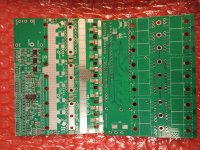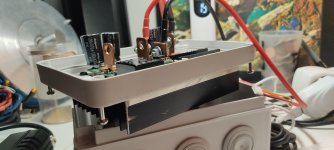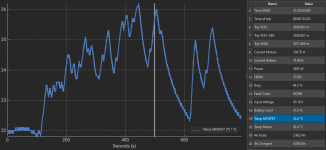I assume youre referring to the pill. I agree with the "general rule" and normally use it. The MP2 crew wanted to minimize noise on the pill as much as possible -- badgineer (who designed the MP2) read up on the subject and suggested we try the two inner ground layers. I would not say that we have tested if it makes any difference, but so far we've been very pleased with the lack of noise issues on the pill. Others among our ranks wrote off the discussion as "witchcraft".

Owhite and Badgineer watched this:
And decided 2 grounds were the best option.
Personally i go for 1gnd 1 power but either works...
EDIT:
In case anyone reads this in future, my rationale is as follows:
1) It is quite hard in more complex designs to add decoupling caps everywhere on every pin, they are a pain.
2) The problem with trace routing is parasitic inductance which limits di/dt and therefore makes it harder to supply the MCU pins.
3) Within a plane, moving current loops between any two points has as low an inductance as to be negligible. This is because the inductance comes from changing magnetic loop around the current carrying trace, but with a plane, the magnetic loop has to extend all the way around the edges of the plane and so it is both a very long (weak) magnetic loop and also does not change much -> very low parasitic inductance.
Very well, but what about the return path on signals?
Well, when you have a trace and you route it above a ground plane, two things happen. Firstly, the return current can flow directly under the trace, and secondly, the presence of a plane under the trace blocks/absorbs the changing magnetic field, by generating Eddie currents in the plane. So:
4) When you route a trace over a power plane, you are still blocking the changing magnetic field around that trace, and so the inductance of the trace is minimised in the same way as if it was over a power plane.
5) The return path is compromised to some extent, but the effect is far subdued below what it immediately looks like because of the presence of the power plane. The return path can take all kinds of tortuous routes within the power plane and ground plane until it finds a decoupling capacitor - and there is near zero parasitic inductance in the planes. Therefore, the power plane is nearly as effective as the ground plane in returning the signal.
This became very apparent when I was playing with single layer IMS boards. Single layer should be disastrous for a power stage. The parasitic loops are huge, like half the board in size, the ringing and switch node bounce should be enormous. But it is not. The IMS boards I made switch several hundred amps in 50ns with virtually no overshoot and ringing. On single layer FR4, this would be impossible.
The difference is that the IMS boards have a slab of aluminium 0.15mm below the copper, and this firstly completely blocks the magnetic fields and secondly can act as a return path for the parasitic flux linked through induction of current into the aluminium substrate. If the effectiveness is so visible on a 400A in 50ns switching event, the effectiveness with a piddly little 0.000xA event at a TTL logic or analog signal will be even more so.
So in summary, my more complete opinion on the matter is:
[signal+PWR]-GND-GND-signal is marginally better (which on ultra high frequency designs may be critical!) IF AND ONLY IF you are able to absolutely guarantee the decoupling of every single device on the board through localised capacitors. If you are not able to guarantee this, then foregoing a power plane will have a bigger negative impact than the benefits attained through the better signal returns.
On the MP2, overwhelmingly the biggest source of parasitic inductance and layout issue is the pill to MP2 interface, with the ~cm long pins that are 2cm from some of the signals. And yet there does not seem to be an issue related to this. People like to debate shit they have heard about and are told is a super important issue at the expense of not finding the real issues...
I am a mech eng, and the other day a softy showed me how he had tuned his PID loop using some cunning math to eliminate position errors. I tightened the bolt holding his encoder to the rail and stopped it rattling around.







